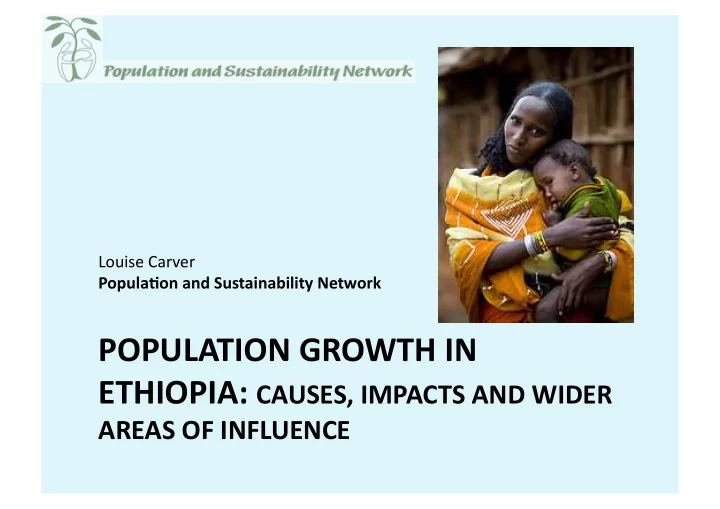

Louise Carver Popula;on and Sustainability Network POPULATION GROWTH IN ETHIOPIA: CAUSES, IMPACTS AND WIDER AREAS OF INFLUENCE
Outline for this evening: 1. Popula1on issues in Ethiopia; 2. Popula1on policy in historical context 3. How can we approach the issue today?
Popula;on in Ethiopia: • Rate of growth: 2.5%/ year • UN projec1ons • Very young age structure • Urbaniza1on rate is double na1onal growth rates
Birth and contracep;on rates: • Fer1lity is 5.1 children per woman • Under 10% of women use modern contracep1on • Unmet need for contracep1on is defined as: “ A woman who would like to delay or prevent her next pregnancy and is not using modern contracep;on” Over a third of married women have an “unmet need” for contracep1on in Ethiopia
Impacts of popula;on growth on Ethiopian development indicators : • Maternal health (one in five deaths for women is due to pregnancy related causes) • Educa1on (primary school enrolment is lower amongst women with large families) • Hinders economic growth • Environmental degrada1on
Impacts of high popula;on growth on development efforts: • Hinder AXainment of the Millennium Development Goals (MDGS) 1. Eradicate extreme poverty and hunger 2. Achieve universal primary educa1on 3. Promote gender equality and empower women 4. Reduce child mortality 5. Improve maternal health 6. Combat HIV/AIDS, malaria and other diseases 7. Ensure environmental sustainability 8. Develop a global partnership for development “The MDGs are difficult or impossible to achieve with the current levels of popula;on growth in the least developed countries or regions” APPG Report, Return of the Popula;on Growth Factor
1. Eradicate extreme poverty and hunger: Reduc1on of percent of popula1on living in poverty not represented in numbers living in poverty: Popula2on Growth Factor, Its Impact on the Millennium Development Goals. 2009 Source: Popula1on and Sustainability Network for 2009 Update for UK APPG Popula1on, Reproduc1ve Health and Development Report. Return of the
2. Achieve universal primary educa1on: Primary school comple1on Total fer1lity rates 2006 rates 2006‐ 2007 Primary School Comple1on Rate Source: World Bank Data in 2009 Update for UK APPG Source: World Bank Data in 2009 Update for UK APPG Popula1on, Reproduc1ve Health and Development Report. Popula1on, Reproduc1ve Health and Development Report. Return of the Popula2on Growth Factor, Its Impact on the Return of the Popula2on Growth Factor, Its Impact on the Millennium Development Goals. 2009 Millennium Development Goals. 2009
Popula;on and reproduc;ve health policies in Ethiopia: • Rates of fer1lity decline – Data shows that fer1lity has declined from 6.4 births per woman in 1995 to 5.4 births per woman in 2005 • Government commitment to family planning programs? – S1ll very low • Abor1on law (2005) one of the most progressive in Africa
Popula;on and Environment: Malthusian worries in the 21 st Century • Debate around the rela1onship because it is difficult to achieve consensus in a generalized way… • Rela1onship is beXer observed on a case by case basis, illustrated in Ethiopia
Popula1on Growth and Environmental concerns‐ Ethiopia Ethiopia’s environmental makeup: Desert in the east Rainforest in the west High al1tude vegeta1on in the central, southeastern and northern highlands Human dependency on environment is high Popula1on growth of 2.7 %/ year has accelerated land degrada1on
“There are no jokes in wife and land” ( proverb used by farmers in northern Ethiopia..) Land degrada1on is caused by the following: – Popula1on growth – Unsustainable land use – Ambiguous land ownership policies… Increasing family size (decreased land holdings) + unsustainable prac1ces = produc1vity
Popula1on and the Ethiopian environment… • Examples of environmental concerns – Deser1fica1on – Water shortages – Land degrada1on – Soil erosion • Deforesta1on – Es1mated to be at 150,000‐200,000 hectares annually which if con1nues at this rate could denude country in as liXle as 20 years
Distribu1on of popula1ons • Land per capita seems ample but what is important is density: • Popula1ons organize themselves according to environmental condi1ons • Most of lowlands are not suitable for habita1on due to malaria and water shortages • Majority of popula1on (80%) and 70% of livestock live in ecologically fragile highlands • Such highlands cons1tute only 45% of available land area
1. Inefficient farming techniques require large areas of land Food 4. Farmers have to share same 2. Low use of soil conserva;on piece of land Insecurity exer;ng even techniques more pressure 3. Increasing family size and soil erosion means less arable land
The effects of landlessness.. • Urbaniza1on • Deforesta1on • Expansion to marginal areas
Mul1‐sector approach: pioneered in Ethiopia • Popula;on‐Health‐ Environment Framework examples from Ethiopia Where do these three meet?: • – Popula;on ‐ Environment (popula1on pressure, migra1on, overexploita1on of land ) – Environment‐ Health (food and water security, diseases and Before trees were re‐planted in the pests) village where these women live they were walking up to 25km a day to – Health‐ Popula;on (sexual collect wood. and reproduc1ve health through family planning, infant and maternal health)
Wichi Provence in eastern Ethiopia, case study : Project has three central ac1vi1es: Educate local inhabitants on sustainable land use prac;ces Rehabilitate areas through reforesta;on programs Introduce family planning services
Guiding Principle: Individuals cannot exercise adequate stewardship over natural resources unless their basic needs for health, nutri;on and economic well‐being are addressed.
Preliminary results show success: Contracep;ve prevalence that was ini;ally very low now stands at around 30% use. Which is three ;mes the na;onal average.
Climate Change‐ poor countries will be hit earliest and hardest: • Most vulnerable to impacts • Have less capacity to adapt • Rapid popula1on growth underscores both
Climate Change adds an extra dimension to pop‐ environment model • Rapid popula1on growth can make adapta1on to the changes and impacts much harder
Ethiopia’s Na1onal Adapta1on Program of Ac1on (NAPA) • SubmiXed to the UNFCCC by Ethiopian Government in 2007 • Acknowledges that popula1on pressure is one of key causes of climate change vulnerability as it impacts on: Loss of natural habitat Soil Degrada;on/ Over farming Deser;fica;on Deforesta;on
Recommend
More recommend